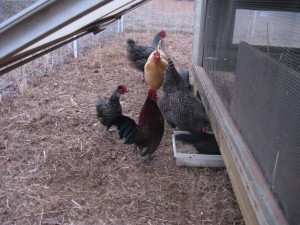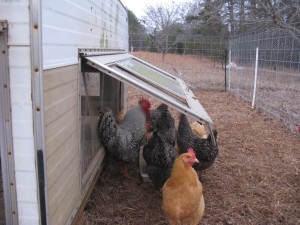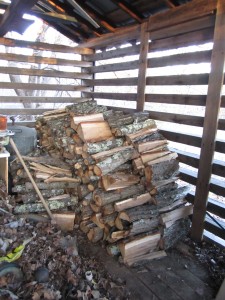i often wonder about different people’s motivations for choosing certain breeds of chickens. some choose chickens that lay many eggs, others choose chickens that are showy and beautiful to look at. still others choose chickens to be their friends or those that are friendly around adults and children. many choose chickens who are better at foraging and taking care of themselves.
i’ve mentioned before that we have both standard chickens and bantam chickens. i wanted to take some time to describe the differences (that we’ve experienced) between these birds of a feather, just in case you’re interested in how their traits may fit into your lifestyle as a chicken owner.
the standards that we have are barred rock (black and white speckled) and buff orpington (which look much like any regular chicken except they are golden/tan in color). our standard rooster, rex, is a barred rock and looks much like the bird on the rex goliath wine bottle.
our bantam chickens are all mutts. each of our females are primarily black, some with varying neck colors such as white speckled or golden banded. our bantam rooster, roosty, has a lovely, deep green tail and an orange-red body and neck.
now, before i compare their observed personalities and traits, i think i should mention the nicknames that jason and i have given the different breeds. we got the buffs and the barred rocks a few weeks before the bantams and spent our first few weeks as chicken owners comparing these two breeds. i started calling the buffs the “pilgrims” and the barred rocks the “blackfeet,” partly on account of their gray legs (while the buffs have cream colored legs) and partly because of the blackfeet native american tribe. our joke was that when the pilgrims showed up in north america, they were less survival fit and “stupider” than the resident native americans. this reflected in our flock, where the barred rocks seems to be less ditsy and clueless about the basics of finding food and avoiding walking feet.
once the bantams arrived, we continued the nicknames, but quickly realized that the blackfeet couldn’t hold a candle to the survival skills of the smaller, speedier chickens.
after many months of observation and chicken chasing, i have a few thoughts about standard chickens vs. bantams. keep these in mind as you make choices about the makeup of your flock.
the standards (barred rocks and buff orpingtons):
- slower and easier to catch if they escape. they are also much more reliant on their “homebase” than the bantams and if they happen to escape stay close to the others inside the fence rather than laying low and hiding in bushes.
- pushier and less skiddish of humans. when it’s feeding time, they are always underfoot!
- less busy finding their own food in the earth. don’t get me wrong, all chickens do the scratch-and-step-back but i find the standards spend much more time lazying around the yard than the smaller guys.
- they tend to go into the house to roost later in the day than the bantams.
- rex draws much more attention to himself than roosty does. he likes to show off and is quick to stand in defense of his ladies and put on a big show.
- they move differently than the bantams, for sure. they are much more dinosaur-like, both in their walk and in their features. to me they are very t-rex like (and lean forward clunkily when they run).
- the breeds we have are good layers, with each hen laying around 250 eggs per year.
- rex is a good, loud crower!
- they have average or medium sized eggs that range from tan to light brown in color.
the bantams:
- much faster runners and expert dodgers. on the occasions that they have escaped they have tried to roost in bushes and fallen trees and have waited a long while to come back out of hiding. jason is fast and not afraid to dive for a chicken and yet these skills have rarely earned him a feathery prize! i am constantly amazed at how fast those little buggers can move.
- prefer to fly under the radar when feeding time comes. the standards pick on them a little but they stay at the fringe of their yard when any humans happen in. they are very aware of where we are at all times and will always stop eating to run away from us, unlike the standards.
- almost always busy searching for little snacks or taking dirt baths. they never seem idle and are constantly on the lookout.
- they tend to head into the house to roost at the first sign of dark.
- roosty doesn’t have much “bark” but jason and i suspect he has a whole lot of “bite” when it comes down to taking care of his flock. his spurs are also 3 inches long and he is such a fast little mover that i am more wary of him than of rex, whose spurs are still coming in and only an inch long.
- the bantams move like sure-footed little quails who seem to float over the ground when they run. they appear to be dainty and are more lady-like rather than their lumberjack-like roomates.
- our bantam hens are not as prolific as the standards, and we only get a few eggs per week from the whole flock. this could be due in part to their age; my father had many of these hens for years before giving them to us and the standards have just now matured and started their adult cycle.
- my father has also observed over the years that many of the hens are good mothers, even raising standard chicks if they hatched them. they are very protective and good at teaching their babies how to be chickens. this is a trait to look for in chickens, with not all breeds (or individuals) having the mothering instinct as strongly.
- roosty is also a good, loud crower but he sounds as if he hasn’t yet gone through puberty. his crow is much higher pitched!
- their eggs are smaller than standard eggs, but the yolk is about the same size with less egg white. their eggs are off-white in color.
overall, i would choose a similar situation if we had to make the choice about chickens all over again. the standards give us many eggs and the bantams are lovely to look at while also being great mothers for our future chickens. they both provide meat for our household and they are equally valuable, in different ways. the standards eat more, but also produce more.
we love having a mixed flock. or rather, two flocks living harmoniously together. the roosters do not fight–perhaps because they do not bother or claim each others’ hens and all chickens roost and eat together. it is one fun and complex extended family we have in our front yard, and it’s perfect for us.
we recommend raising both standards and bantams, and trying them out together (at least at first) to see if they can co-exist peacefully and productively!
.:.





